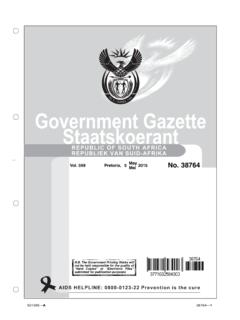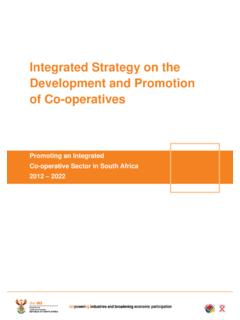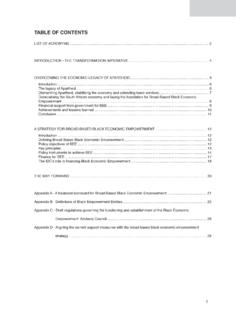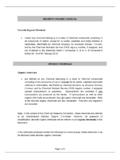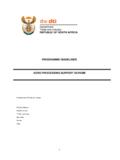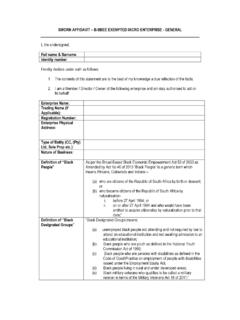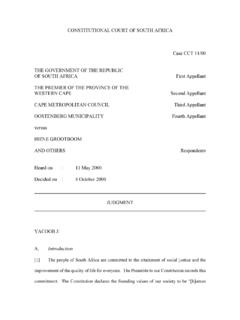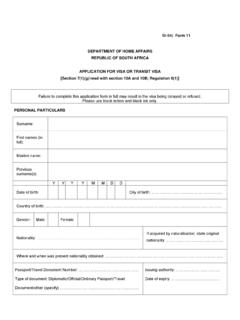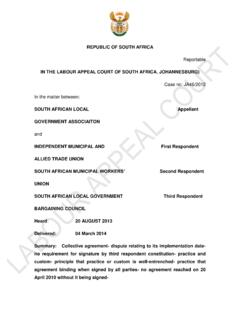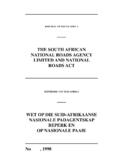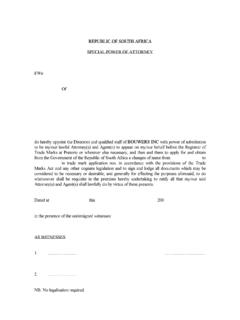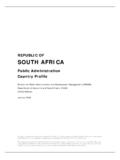Transcription of INTELLECTUAL PROPERTY POLICY OF THE …
1 INTELLECTUAL PROPERTY POLICY OF THE republic OF south africa PHASE I Division: International Trade and Economic Development 1 INTELLECTUAL PROPERTY POLICY of The republic of south africa Phase I 2018 Contents 1. List of Abbreviations .. 2 2. 3. Problem Statement ..7 4. Purpose ..9 5. Strategy .. 12 6. IMCIP .. 13 7. Phase I .. 14 IP and public health .. 14 Local manufacture and export in line with industrial POLICY .. 15 Substantive Search and Examination .. 17 Patent Opposition .. 19 Patentability Criteria .. 21 Disclosure Requirements .. 22 Parallel Importation .. 23 Exceptions .. 25 Voluntary Licences .. 27 Compulsory Licences .. 27 IP and Competition Law .. 29 Rule of Law, Legal Certainty & Security of Investments .. 31 International IP Cooperation .. 34 Multilateral Arrangements .. 35 Regional and Bilateral Arrangements .. 40 8. In-Built Agenda .. 42 Medium 42 Monitoring & Evaluation.
2 45 9. Conclusion .. 46 2 1. List of Abbreviations ABS Access and Benefit Sharing ACIP Australia s Advisory Council on IP AMR Antimicrobial resistance ARIPO African Regional INTELLECTUAL PROPERTY Organization AU African Union BRICS Brazil, Russia, India, China, south africa CBD Convention on Biological Diversity CIDP Committee on Development and INTELLECTUAL PROPERTY CIPC Companies and INTELLECTUAL PROPERTY Commission CEDAW Convention on the Elimination of all Forms of Discrimination against Women and Girls CEWG Consultative Expert Working Group on Research and Development: Financing and Coordination CRC Convention on the Rights of the Child CRPD Convention on the Rights of Persons with Disability G20 Group of 20 GI Geographical Indication ICESCR International Covenant on Economic, Social and Cultural Rights IMCIP Inter-Ministerial Committee on INTELLECTUAL PROPERTY IP INTELLECTUAL PROPERTY IPAP Industrial POLICY Action Plan IPR INTELLECTUAL PROPERTY Rights LDC Least Developed Countries LMMC Like-Minded Mega-Diverse Countries NDP National Development Plan NGP New Growth Path Framework NEDLAC National Economic Development and Labour Council NIPF National Industrial POLICY Framework OAPI Organisation Africaine de la Propri t Intellectuelle PAIPO Pan African INTELLECTUAL PROPERTY Organization PCT Patent Cooperation Treaty R&D Research and development SDG Sustainable Development Goals SADC Southern African Development Community SAHPRA south African Health Products Regulatory Agency SMMEs Small.
3 Medium and micro-enterprises SSE Substantive Search and Examination the dti The Department of Trade and Industry TRIPS The Agreement on Trade-Related Aspects of INTELLECTUAL PROPERTY Rights UNCTAD United Nations Conference on Trade and Development UNDP United Nations Development Programme UNHLP United Nations Secretary General s High Level Panel on Access to Medicines UPOV International Convention for the Protection of New Varieties of Plants WHO World Health Organization WIPO World INTELLECTUAL PROPERTY Organization WTO World Trade Organization 3 2. Introduction The National Development Plan (NDP) of south africa calls for a greater emphasis on innovation, improved productivity, an intensive pursuit of a knowledge economy and the better exploitation of comparative and competitive advantages. INTELLECTUAL PROPERTY (IP) is an important POLICY instrument in promoting innovation, technology transfer, research and development (R&D), creative expression, consumer protection, industrial development and more broadly, economic growth.
4 south africa s economic development strategy aims to accelerate growth along a path that generates sustainable and decent jobs in order to reduce poverty and the extreme inequalities that characterise our society and economy. The National Industrial POLICY Framework (NIPF), implemented through the Industrial POLICY Action Plan (IPAP), is a central component of our economic development strategy. The NIPF and IPAP seek to encourage and upgrade value-added, labour-absorbing industrial production, and diversify the economy, by moving away from the current over-reliance on commodities and non-tradable services. Knowledge, innovation and technology are increasingly becoming the drivers of progress, growth and wealth. Therefore, south africa needs to transition towards a knowledge economy, and away from an over-reliance on natural resources. A specific framework of conditions is necessary to enable south africa to make this transition, and an IP POLICY is one of the core elements required to achieve this objective.
5 The south African Constitution already protects INTELLECTUAL PROPERTY rights (IPR) from arbitrary deprivation and in recent decades, south africa has made significant strides in the just protection, administration, management, and deployment of IP. Statutes relating to IP in south africa include, but are not limited to: INTELLECTUAL PROPERTY Rights from Publicly Financed Research and Development Act 51 of 2008 National Environmental Management: Biodiversity Act 10 of 2004 Patents Act 57 of 1978 Merchandise Marks Act 17 of 1941 Copyright Act 98 of 1978 Designs Act 195 of 1993 Plant Breeders Rights Act 15 of 1976 Trade Marks Act 194 of 1993 Despite attention paid to IP law-making in the country, there is a need for a comprehensive IP POLICY that will promote a holistic, balanced and coordinated approach to IP that is mindful of the many obligations mandated under the south African Constitution.
6 4 The goals of this comprehensive IP POLICY are: To consider the development dynamics of south africa and improve how IP supports small institutions and vulnerable individuals in society, including in the domain of public health To nurture and promote a culture of innovation, by enabling creators and inventors to reach their full potential and contribute towards improving the competitiveness of our industries To promote south African arts and culture To solidify south africa s various international obligations, such as the Convention on Biological Diversity (CBD) and the Nagoya Protocol on Access to Genetic Resources and the Fair and Equitable Sharing of Benefits Arising from their Utilisation (Nagoya Protocol on ABS), in the service of our genetic resources and traditional knowledge associated with genetic resources The strategy employed in this comprehensive IP POLICY includes: Advancing a balanced and coordinated approach to IP that regulates IPRs in line with the south African Constitution Introducing key POLICY reforms that account for the development dynamics of south africa Promoting innovation and a knowledge economy Leveraging competitive and comparative advantages to advance the transformation of the south African economy The overarching objective is to ensure that this comprehensive IP POLICY becomes a just, balanced, and integral part of the broader development strategy for south africa by assisting in transforming the south African economy, and thereby leveraging human resources for the broader economic benefit, increasing local manufacturing, and generating more employment.
7 The comprehensive IP POLICY will be implemented in a phased approach. The current document constitutes the first phase in what will be a comprehensive POLICY to be developed and updated over the medium term. Phase I covers IP and public health, coordination in international forums, and the implementation of commitments undertaken in international agreements. Phase I priorities have been identified on the basis of south africa s development objectives, supplemented by research, analysis, and experience, as well as assessments of existing capacity to implement the measures outlined herein. The comprehensive IP POLICY proposes key reforms that are aimed at advancing south africa s socio-economic development objectives as outlined in key POLICY documents of the national government, such as the National Development Plan (NDP), the New Growth Path Framework (NGP), National Drug Plan, NIPF and the various iterations of IPAP.
8 5 The key reforms include: The introduction of substantive search and examination (SSE) for patents, which is a key step towards ensuring that the patent regime fulfils its purpose of stimulating genuine innovation. This will benefit patent holders by granting them rigorously assessed rights, and benefit the public at large by ensuring that market exclusivity is only granted when appropriate. Importantly, SSE will not only apply in the health sphere; it will eventually have much broader application. However, with due regard to capacity constraints and resources, the IMCIP in consultation with diverse stakeholders will determine the initial fields in which full SSE will occur. These fields will be progressively expanded, as the capacity of the state increases. The leveraging of flexibilities contained in the Agreement on Trade-Related Aspects of INTELLECTUAL PROPERTY Rights (TRIPS) to ensure that south africa protects IPRs while simultaneously promoting public health, local manufacture, research and development, innovation, food security, environmental considerations, transfer of technology and broad socio-economic development.
9 The promotion of regional cooperation and integration in IP. A commitment to all rel evant international obligations south africa is party to. The promotion of economic empowerment through, among other means, the implementation of the utility model to support the registration of patents by resident small, medium and micro-enterprises (SMMEs), historically disadvantaged individuals, and companies who are operating in the informal sector. This entails enacting exclusivity similar to a patent right, granted by a state, to an inventor or the inventor s assignee, for a fixed period of time. However, the terms and conditions for granting a utility model are slightly different from those for ordinary patent, including a shorter term of protection and less stringent patentability requirements. The term utility model is sometimes addressed differently in other countries, with the terms petty patents , short-term patents or innovation patents.
10 A coordinated approach to creating awareness about IP among south Africans, so as to protect nationally-owned IP that is related to indigenous resources, traditional innovation and traditional knowledge. The creation of a system for protection for traditional knowledge which will guard against misappropriation and exploitation, as well as promote further research and development into products and services based on traditional knowledge. The promotion of international best-practices in IP that align with south africa s development objectives. 6 The IP POLICY is ordered as follows: Section 3 contains the problem statement that sets out the need for the IP POLICY and the key issues it will address. Section 4 consists of the purpose of the IP POLICY within the context of south africa s broader development objectives. Section 5 contains the strategy which outlines a phased-approach towards the development of a comprehensive IP POLICY .

